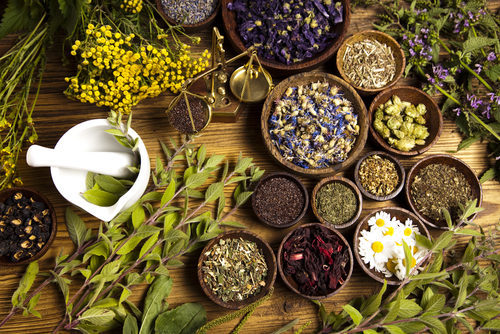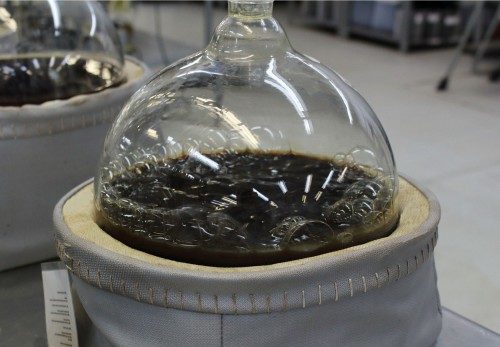Energique’s and Forza Vitale’s Spagyric Process
Full-Spectrum Spagyric Plant Extracts: Traditional Herbal Wisdom . . . Transformed with Modern Science Techniques
 Energique and Forza Vitale each use a proprietary method, called Spagyric Processing, to produce their liquified herbals. The process of preparing spagyric herbal tinctures originated with the alchemists and was defined by Paracelsus, in the 16th century. Because the process produces a more complete extraction of herbs, that includes both water soluble and oil soluble constituents of the plant, spagyric herbal tinctures present a more potent, bioavailable form of herbal preparation. This method of extraction is still utilized today by a handful of manufacturers to create the highest quality, handcrafted remedies available. So, you could argue that spagyric products are alchemical preparations that are truly golden.
Energique and Forza Vitale each use a proprietary method, called Spagyric Processing, to produce their liquified herbals. The process of preparing spagyric herbal tinctures originated with the alchemists and was defined by Paracelsus, in the 16th century. Because the process produces a more complete extraction of herbs, that includes both water soluble and oil soluble constituents of the plant, spagyric herbal tinctures present a more potent, bioavailable form of herbal preparation. This method of extraction is still utilized today by a handful of manufacturers to create the highest quality, handcrafted remedies available. So, you could argue that spagyric products are alchemical preparations that are truly golden.
There seems to be more than one version of the following: “Spagyric” comes either from the Greek words spaein (divide, separate) and agarein (unite) or from the Greek words spao (I collect) and ageiro (I extract). Alternatively, spao might be better rendered as separate or divide. Whichever is more correct, dividing and uniting represent the basis of the Spagyric processing method, which the alchemists believed to be a more perfect means of extracting the medicinal virtues of plants. Benefits of Spagyric processing has certain benefits. It:
- ensures maximum extraction of the raw material,
- includes the vital healing components of plant minerals, found mainly in the pulp and only available by this means of extraction, and
- creates a product that is more potent and bioavailable than the original raw material, while leaving all the original trace minerals and elements from the water-soluble, oil-soluble, non-mineral and mineral components intact.
At a time when little was known about plant chemistry, the technique of the alchemists sought to extract what they considered to be the threefold essence of the plant, and anticipated with remarkable insight our modern understanding of botanical medicine.
While the traditional tincture process simply disposes of the residual plant matter after extraction is complete, to prepare a spagyric tincture, the remaining plant matter is first combusted and then reunited with the liquid extract. The result is a tincture with significantly enhanced bioactivity and bioavailability, blending ancient herbal wisdom with the insights of modern science.
Many of the most important active constituents of plants, such as polyphenols and sesquiterpene lactones, are poorly soluble in water and show remarkably poor bioavailability. In some cases, they may not be absorbed effectively by the body. While traditional herbal tinctures use alcohol to extract these lipid-soluble components, they do nothing to enhance their bioavailability. But, in the spagyric process, the tincture is repeatedly evaporated and recondensed in a closed vessel. This is a technique originally developed by the alchemists, which they called recirculation.
 The process of recirculating the tincture — subjecting it to repeated evaporation and recondensation — was meant to simulate in a glass vessel the natural process of precipitation. Alchemists believed that, by this process, the plant’s healing power could be brought to perfection. As if to confirm the inherent wisdom of this archaic concept, it has since been discovered that the process of recirculating the tincture produces small cavitations in the water, allowing it to form nano-emulsions with the plant’s lipid-soluble components. These nanoparticles essentially act as carriers which can then deliver the plant’s active constituents into the body and directly across cell membranes, resulting in dramatically enhanced bioavailability.
The process of recirculating the tincture — subjecting it to repeated evaporation and recondensation — was meant to simulate in a glass vessel the natural process of precipitation. Alchemists believed that, by this process, the plant’s healing power could be brought to perfection. As if to confirm the inherent wisdom of this archaic concept, it has since been discovered that the process of recirculating the tincture produces small cavitations in the water, allowing it to form nano-emulsions with the plant’s lipid-soluble components. These nanoparticles essentially act as carriers which can then deliver the plant’s active constituents into the body and directly across cell membranes, resulting in dramatically enhanced bioavailability.
The use of a closed vessel also protects the tincture from exposure to oxygen, reducing oxidation and allowing the tincture to retain more of its natural color. The temperature of the liquid extract is closely monitored throughout the entire process to ensure that the plant’s organic active constituents remain undamaged.
In addition to its numerous organic phytochemicals, each medicinal plant is also characterized by a unique profile of minerals and trace metals. These important elements, which are selectively absorbed and concentrated by different plant species, are believed to contribute to each plant’s overall medicinal effect.
Some of these minerals, like iron and magnesium, have well-known functions and act as essential minerals in the body. Others, like silver and germanium, while not essential to the body, are now known to have valuable effects on healing and the immune system.
The medicinal properties of different metals were well known to the alchemists, who always sought to preserve the original synergy of the whole plant in their medicines. It was their belief that everything in the universe was possessed of a threefold nature, a triune of body, spirit, and soul. They referred to these essences symbolically as salt, mercury and sulphur, and recognized that different extraction methods would concentrate these virtues differently, long before the advent of the modern science of plant chemistry.
Now, it is well known that most plants contain both water-soluble constituents and volatile components which are better extracted in ethanol. These correspond, respectively, to the alchemical principles “mercury” and “sulphur.” But there is also the alchemical “salt”, comprising the minerals, trace metals and plant cells salts, many of which are insoluble in water or ethanol. As a result, very few of these important minerals are to be found in traditional tinctures, but remain, for the most part, locked within the original plant material.
The liberation of these intracellular minerals, through the process of combustion, is a crucial part of the spagyric extraction process. Instead of simply disposing of the original plant material, after combustion, the mineral-rich ash is fully incorporated into the final product. This ensures that no part of the plant is wasted, and enriches the tincture with a full spectrum of plant cell salts and oligominerals. Throughout this entire process, the temperature of the liquid extract is closely monitored to ensure that the plant’s organic active constituents remain undamaged. While more time-consuming than other extraction methods, this process produces a more bioactive herbal medicine, combining oligotherapy, supplemental trace minerals, plant cell salts and electrolytes, to further support the body and enhance detoxification processes.
